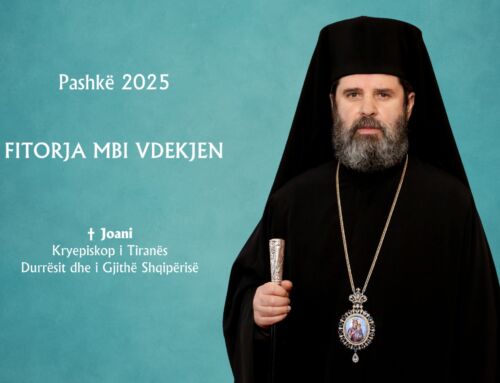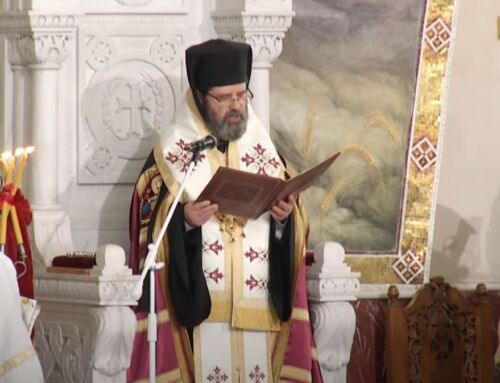Russia: Time of Troubles
In the seventeenth century Russia entered the “time of troubles.” Boris Godonov, who ruled from 1598, died in 1605. Basil Shuiskii ruled until 1610 when a Polish tsar was crowned. During this time of political and social upheaval the Poles seized control of the country. They captured Moscow and the monastery of St. Sergius. Patriarch Germogen, the national leader, was imprisoned and starved to death in 1612, later being canonized a saint. From the end of the reign of Ivan III Russia was besieged with political turmoil, famine, and national disaster. Saint Juliana Ossorgine (d.1604) was glorified by the Church at her canonization for her compassionate love and care of the suffering people.
Russia: The Old Believer Schism
The “time of troubles” was followed in northern Russia by the Old Believer Schism. Michael Romanov (d.1645) was crowned tsar in 1613. His father Philaret (d.1633) became the patriarch of the church and the country’s actual ruler in 1619. From 1645-1676 Alexis Romanov, a most devout and pious man, ruled as tsar. In 1652 Alexis chose the extremely popular and talented metropolitan of Novgorod, Nikon, to be patriarch of the Russian Church. Nikon refused the position at first. He accepted when he received the formal pledge of the leaders of church and state that they would give unwavering obedience to the gospels, the canons, the fathers of the Church, and to him personally as the “chief pastor and supreme father” of the Russian Church. During Great Lent in 1653 Nikon began his reforms of church practices which were to rend asunder both church and nation.
The reforms of Nikon were reasonable and un-revolutionary by modern standards. They called for the adjustment of the Russian liturgical practices to conform with those of the other Eastern Orthodox Churches. They called for corrections in the wording and spelling of liturgical texts. Concretely this reform meant that the Russians would henceforth cross themselves with three fingers instead of two, sing “alleluia” three times during psalmody instead of twice, and make other similar changes. In the Russia of Nikon’s time such reforms – which appear slight today – were explosive. They directly denied the “third Rome” theory and practice of the Russian church and state. They put Russian Orthodoxy in subjugation to the Eastern patriarchates which were presently suffering under the Turks because of their sins (according to Russian mentality).
In 1657 the tsar Alexis returned from the fighting on the Polish front to find his church and nation in chaos. The opposition to Nikon was led by parish priests who themselves were considered “reformers” because they had been calling for a return among the people to strict obedience to the traditional rites and customs of the Russian Church. Nikon, who acted as the tsar’s regent in his absence, felt confident that Alexis would support his actions by punishing those who were disobedient to him as “chief pastor and supreme father” of the Russian Church. The tsar, however, was not pleased with Nikon’s actions. His open statement of displeasure caused the patriarch to resign in 1658 after publicly rebuking the tsar. From that time until 1666 Russia had no acting patriarch.
Alexis tried to make up with Nikon, but to no avail. In 1666 the Eastern patriarchs were consulted. A council was called in Moscow, presided over by the bishops of Alexandria and Antioch. It was engineered by the unscrupulous Metropolitan of Gaza, Paisios Ligarides. The council first excommunicated the opponents of Nikon’s reforms – several million believers – from the Church. These opponents of Nikon, led by the Archpriest Avvacum, were called the Old Believers or Old Ritualists. The council then unfrocked Nikon for deserting his office and for showing disrespect to the tsar, The council officially refuted the Council of a Hundred Chapters which was held in 1551 – the most venerated of Russian Church councils. Thus the council of 1666-1667 formally renounced the “third Rome” theory and the assumed supremacy of Russian Orthodoxy over all other churches.
Nikon remained under arrest until he died in 1681. Although he never changed his position and never yielded his opposition to the council of 1666-1667, he was buried in the church with full patriarchial dignity. The opponents of Nikon, the dissenting Old Believers, rejected the council and went into schism with the official Russian Church. Their leaders, such as Avvacum, were sought out and violently persecuted. They were sent into exile and harsh labor, a condition which endeared them to the masses of people who shared their rigorous, conservative, unyielding spirit. Archpriest Avvacum was burned alive with three of his supporters in 1682 for the “great blasphemies… uttered against the tsar and his household.” His autobiography has become a classic of Russian literature.
In 1682 Peter the Great became tsar. His extreme and violent attempts to westernize Russia, and his fierce opposition to traditional Russian ways caused the dissenters to think of him as the Anti-Christ. The Old Believers, in their desire to preserve the pure Orthodox faith and rituals of Russia, succeeded in preserving ancient Russian forms of iconography and liturgical chant which otherwise would likely have been lost in history.
The Unia
In the seventeenth century, in the south of Russia, the unia continued in force, although large amounts of territory had been won back by the Russians. The lay brotherhoods in the Ukraine and Galicia served Orthodoxy well during this time by their absolute rejection of the uniate movement. Among these lay leaders were Constantine Ostrozhskii (d.1608) and Mileti Smotritskii who wrote his Lamentations of the Eastern Church in 1610.
Peter Moglia
In 1615 the theological academy of Kiev was founded. In 1620 Theophanes, the Patriarch of Jerusalem, consecrated seven bishops for the Orthodox in secret from the government. In 1633 Wladyslaw IV, the successor to Sigismund, gave permission for an Orthodox metropolitan of Kiev. Peter Mogila (d.1647), the leading man of the Kiev theological school, was chosen. Mogila was fiercely anti-Roman but he was trained in Latin schools and had a deep respect for Latin scholastic learning. Through his many works, which in- cluded a Slavic translation of the catechism of the Jesuit Canisius and a priest’s Service book, Latin influences entered the Orthodox Church in doctrinal formulation and liturgical practices. Mogila’s works were judged acceptable by the Orthodox bishops in a council in Kiev (1640) and again in Jassy, in Moldavia (1643). Nevertheless, together with the forced westernization of Peter the Great’s policies, they were a primary cause for almost two hundred years of captivity to Western influences in the theology and piety of the Orthodox people.
Cyril Lukaris
Cyril Lukaris (d.1638) served as patriarch of Alexandria and patriarch of Constantinople on seven different occasions under the Turks before they finally drowned him. His “confession of faith” was forthrightly condemned by the same church councils in Kiev and Jassy which upheld the orthodoxy of Peter Mogila’s catechism and service books. The “confession” of Cyril was a thoroughly Calvinist statement of faith. In 1662 a council of Eastern patriarchs in Jerusalem confirmed the decisions of the council of Jassy, and published a “Confession of Faith of the Eastern Patriarchs.”
The East
In the seventeenth century, the Turks destroyed the independence of the Serbian and Bulgarian churches. They submitted them directly to Constantinople thus establishing the Greek “Phanariot” rule over the non- Greek Orthodox Christians in the Turkish empire. At this time in Russia, the bishop Saint Dimitri of Rostov (d.1709) published his spiritual writings which included a twelve-volume edition Of the Lives of the Saints. The holy abbot, Saint Job (d.1651) of the Pochaev monastery also lived at this time.
The West
In the West the nations were recovering from the religious upheavals of the reformation and counter-reformation. America was being settled by the religious dissenters from England: Puritans, Congregationalists, Baptists, and Quakers who were members of the Society of Friends founded by George Fox (d.1691), In 1611 in England, the King James Version of the Bible was published. The Roman Church of this time was troubled by the movement of Jansenism, the doctrine which held that grace is given only to the elect of God. At this time in France, Vincent de Paul (d.1660) founded his order dedicated to the works of charity and service to the poor and sick.


